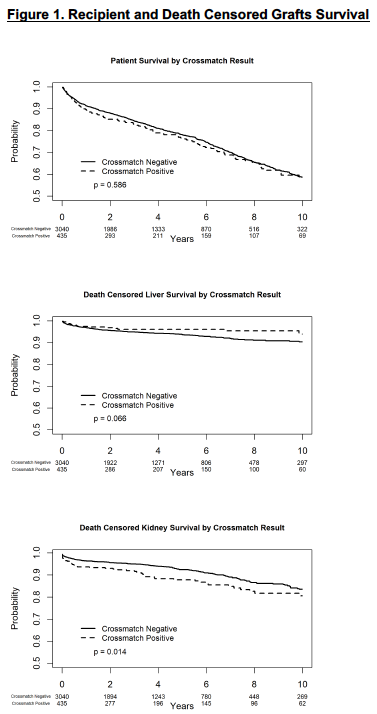Long-Term Outcomes of Crossmatch Positive Simultaneous Liver Kidney Transplants in the United States
1Medicine, University of Minnesota, Minneapolis, MN, 2Mhealth-Fairview, Minneapolis, MN, 3Surgery, University of Minnesota, Minneapolis, MN
Meeting: 2022 American Transplant Congress
Abstract number: 127
Keywords: Highly-sensitized, Histocompatibility, Organ Selection/Allocation
Topic: Clinical Science » Liver » 52 - Liver: Kidney Issues in Liver Transplantation
Session Information
Session Name: Cirrhosis: Complications, Portal Hypertension and Renal Management
Session Type: Rapid Fire Oral Abstract
Date: Sunday, June 5, 2022
Session Time: 5:30pm-7:00pm
 Presentation Time: 6:20pm-6:30pm
Presentation Time: 6:20pm-6:30pm
Location: Hynes Room 311
*Purpose: The long-term results of crossmatch positive (XM+) simultaneous liver-kidney (SLK) transplants are conflicting. We examined the association between crossmatch (XM) status and SLK outcomes in recipients discharged on tacrolimus and mycophenolate with or without steroids.
*Methods: We analyzed the SRTR standard analysis file for all primary SLK recipients between 2003 and 2020 with available XM and induction regimen data. Recipients were grouped according to the XM status: crossmatch negative (XM-) N=3040 and XM+ N=435. Kaplan-Meier curves were generated to examine recipient, death-censored liver and kidney survival by XM status. Cox proportional hazard models were used to investigate the association between XM status and outcomes of interest with follow-up censored at 10 years. Models were adjusted for recipient age, sex, MELD scores, duration on the liver waitlist, induction immunosuppression, steroid maintenance, hepatitis C virus status, donor age and sex, local vs. shared organ status, liver and kidney cold ischemia time and previous liver transplant status.
*Results: In the univariable analysis, XM status was not associated with recipient survival (log-rank p=0.59) or death-censored liver graft survival log-rank (log-rank p=0.066) (Fig 1). However, death-censored kidney graft survival was slightly lower in the XM+ group (log-rank p=0.014). In the multivariable models, XM+ status was not associated with deleterious long-term recipient, liver graft, or kidney graft survival (Table 1). The 1-year liver rejection rate did not differ significantly between groups. The 1-year kidney rejection rate in the XM- group was lower than their counterparts (4.6% vs. 9.5%, P< 0.001). However, 1-year serum creatinine did not differ significantly between the groups.
*Conclusions: XM- and XM+ SLK transplants have comparable long-term outcomes with a slightly increased risk of early kidney allograft rejection but not death censored graft loss in the XM+ group. Crossmatch positivity in SLK transplants should not influence the decision to use organs from a specific donor.
To cite this abstract in AMA style:
Riad S, Aby E, Jackson S, Nguyen P, Lim N, Lake J. Long-Term Outcomes of Crossmatch Positive Simultaneous Liver Kidney Transplants in the United States [abstract]. Am J Transplant. 2022; 22 (suppl 3). https://atcmeetingabstracts.com/abstract/long-term-outcomes-of-crossmatch-positive-simultaneous-liver-kidney-transplants-in-the-united-states/. Accessed December 10, 2025.« Back to 2022 American Transplant Congress


